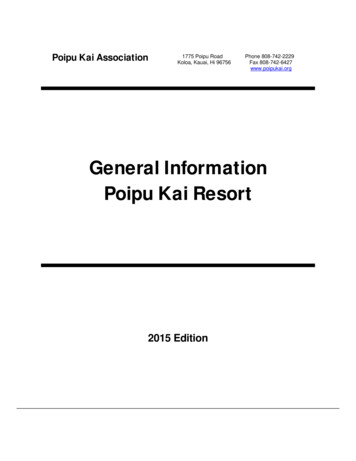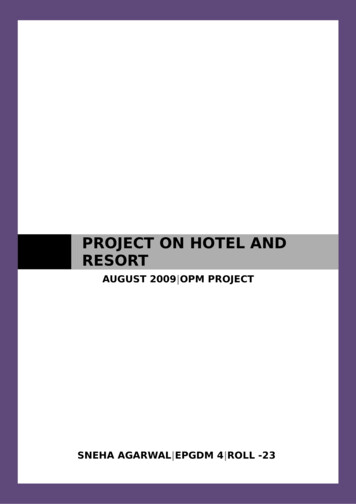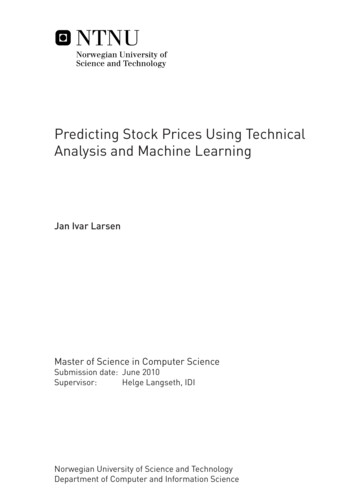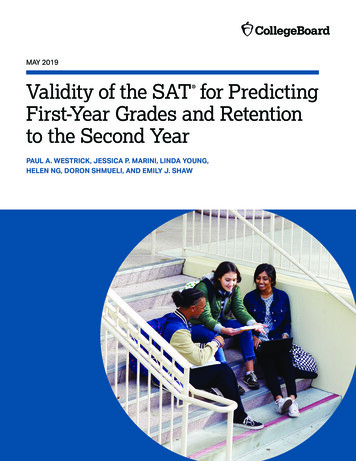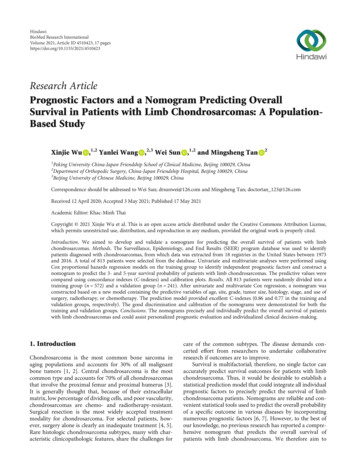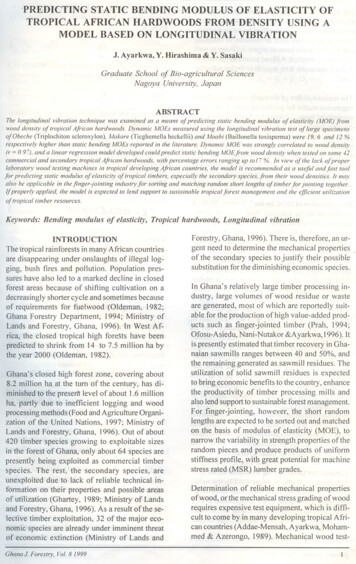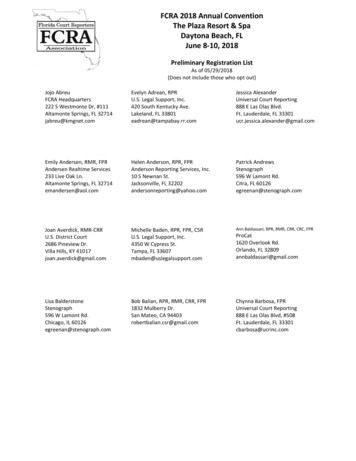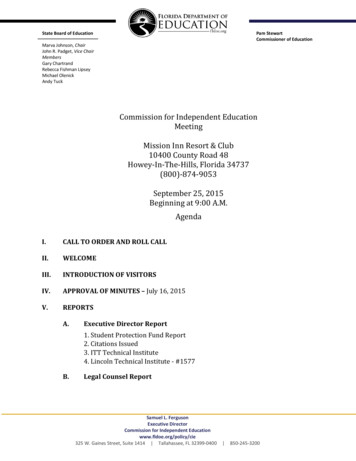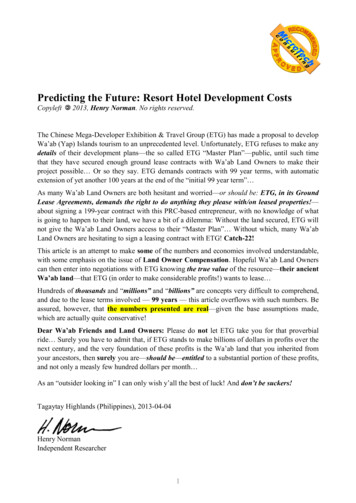
Transcription
Predicting the Future: Resort Hotel Development CostsCopyleft2013, Henry Norman. No rights reserved.The Chinese Mega-Developer Exhibition & Travel Group (ETG) has made a proposal to developWa’ab (Yap) Islands tourism to an unprecedented level. Unfortunately, ETG refuses to make anydetails of their development plans—the so called ETG “Master Plan”—public, until such timethat they have secured enough ground lease contracts with Wa’ab Land Owners to make theirproject possible Or so they say. ETG demands contracts with 99 year terms, with automaticextension of yet another 100 years at the end of the “initial 99 year term” As many Wa’ab Land Owners are both hesitant and worried—or should be: ETG, in its GroundLease Agreements, demands the right to do anything they please with/on leased properties!—about signing a 199-year contract with this PRC-based entrepreneur, with no knowledge of whatis going to happen to their land, we have a bit of a dilemma: Without the land secured, ETG willnot give the Wa’ab Land Owners access to their “Master Plan” Without which, many Wa’abLand Owners are hesitating to sign a leasing contract with ETG! Catch-22!This article is an attempt to make some of the numbers and economies involved understandable,with some emphasis on the issue of Land Owner Compensation. Hopeful Wa’ab Land Ownerscan then enter into negotiations with ETG knowing the true value of the resource—their ancientWa’ab land—that ETG (in order to make considerable profits!) wants to lease Hundreds of thousands and “millions” and “billions” are concepts very difficult to comprehend,and due to the lease terms involved — 99 years — this article overflows with such numbers. Beassured, however, that the numbers presented are real—given the base assumptions made,which are actually quite conservative!Dear Wa’ab Friends and Land Owners: Please do not let ETG take you for that proverbialride Surely you have to admit that, if ETG stands to make billions of dollars in profits over thenext century, and the very foundation of these profits is the Wa’ab land that you inherited fromyour ancestors, then surely you are—should be—entitled to a substantial portion of these profits,and not only a measly few hundred dollars per month As an “outsider looking in” I can only wish y’all the best of luck! And don’t be suckers!Tagaytay Highlands (Philippines), 2013-04-04Henry NormanIndependent Researcher1
Resort Hotel Development Costs: Theory and Numerical AnalysisTable of ContentsDifferent Developer/Land Owner Agreement Models . 3What Is “Inflation”? . 4Estimating Resort Hotel Development Costs . 6How Much Land Is Required For 1,500 Hotel Rooms?. 9How to Estimate Hotel Average Daily Room Rate (ADR). 10The “Yap Paradise” Resorts, and ETG Cost of Land . 11Revenue, Profits, and Lease (Rent) Payments. 12Conclusions. 15Guide on Excel Workbook Usage . 16Tables and FiguresTable 1:Historical U.S. Inflation Rates 1956-2012 . 4Table 2:Inflation of New Car Purchase Prices 1956-2012 . 5Table 3:Average Budget Cost Allocations (All Hotel Types) . 6Table 4:Typical Hotel Development Costs . 6Table 5:Resort Hotel Development Cost Estimates . 7Table 6:Hotel “Footprint” Size Parameters . 9Table 7:Estimated Land Area (m2) Needed For One Hotel . 9Figure 1: Assumed Average Proportional Hotel Land Utilization . 10Table 8:Total ETG Project Development Cost Parameters. 11Table 9:ETG 99 Year Land Lease Cost (US ). 11Table 10: Hotel Revenue Fundamentals. 12Table 11: “ETG Template” Ground Lease Income Analysis . 13Table 12: ETG/OPP Revenue and Profit Related to ETG Cost of Land. 14Table 13: Potential Lease Income For Wa’ab Land Owners . 142
Resort Hotel Development Costs: Theory and Numerical AnalysisDifferent Developer/Land Owner Agreement ModelsTo acquire land needed for resort hotel projects, developers anywhere are lookingat either (a) Purchase land outright; or (b) Some type of Ground Lease contract.As FSM does not allow land ownership by non-FSM citizens, ETG’s only optionis to enter into some type of Ground Lease contract with the Land Owners, usingseveral different ways to determine fair Land Owner compensation: Fixed Lease Income (Rent): With adequate “inflation protection” (for example,rent tied to the Consumer Price Index (CPI)), in combination with fixed percentage raises at regular intervals (usually 10 years), both parties benefit from knowingthe income stream/lease expense over time. However, the “ETG model,” locking inthe rent to a 10 % increase of only the initial rent every 10 years, leaves the LandOwner with an ever decreasing rent income (in terms of “purchase power”).1 Percentage of Appraised Value: Similar to Fixed Lease, but utilizing rent resetprovisions revaluing the lease based on updated appraisals at regular intervals,where the parties negotiate a rent based on a percentage of appraised value. Thisrent is fixed for a negotiated period of time, generally 10 years. At the end of thecontracted period, a new appraisal is performed, and the appraised value multipliedby the contracted percentage rate, yielding the next 10 years rent. This method isexclusively tied to appraised land value. Partnership (Revenue Percentage): In many cases, the developer gets to usethe land for free, paying the Land Owner a percentage of revenue based upon someagreed-upon algorithm. As this is more risky for the Land Owner — who may beleft with nothing during times of depression — but the percentage is often quitesubstantial (up to 12 % of revenue). Combination Fixed Lease/Partnership: This may well be the ideal—“inflationprotected” and risks and rewards shared between Land Owner and Developer/Operator. Usually, the fixed portion is a number based on minimum earned revenue,so that if earned revenue does not reach the minimum level, the fixed portion is allthe Land Owner receives. If revenue exceeds that minimum, the Land Ownergets—in addition to the fixed portion—a percentage of revenue, increasing to from2 % to 10 % according to some agreed-upon (carefully negotiated!) algorithm.Source: www.hospitalitynet.org (See also: www.hud.gov and www.wcsr.com)In this article, the “ETG Model” is analyzed, and lease income compared to whatthe Land Owner would have received with a reasonably negotiated contract, basedon some method of PPP (Purchase Power Protection).1In effect, the worst imaginable “sucker deal,” borderline cheating But a signed contract is a signed contract!Caveat Venditor—“Let the Seller Beware”—as already the old Romans had discovered!3
Resort Hotel Development Costs: Theory and Numerical AnalysisWhat Is “Inflation”?Economists have debated, agonized and struggled over this monetary phenomenonever since the days of Medici This is what Wikipedia tells us:Inflation is a rise in the level of prices of goods and services in an economy over aperiod of time. When the general price level rises, each unit of currency buys fewergoods and services. Consequently, inflation also reflects an erosion in the purchasing power of money—a loss of real value in the internal medium of exchange andunit of account within the economy. One measure of price inflation is the inflationrate, the annualized percentage change in a general price index (in the U.S., normally the consumer price index (CPI)) over time. Source: en.wikipedia.org.And, in very similar terms, here is what Investopedia tells us:Inflation is the rate at which the general level of prices for goods and services isrising, and, subsequently, purchasing power is falling. Central banks attempt to stopsevere inflation, along with severe deflation, in an attempt to keep the excessivegrowth of prices to a minimum. As inflation rises, every dollar will buy a smallerpercentage of a good. Source: www.investopedia.com (See also this explanatory video clip)In a coconutshell: Over time, all stuff tends to get more expensive — in a fewyears, you’ll need more cash to buy a fixed amount of beer. The “speed” bywhich your money loses value is the “inflation rate,” and is measured as a yearlypercentage.YearlyAverageHistorical U.S. Inflation Rates (%) by Month and Year ince 206.105.806.106.006.006.005.405.705.92Since nce 205.305.204.704.404.704.805.606.205.12Since 703.203.803.103.203.703.703.403.503.37Since 602.102.302.202.001.101.201.101.101.74Since 3.863.883.893.893.893.883.883.893.88Table 1: Historical U.S. Inflation Rates 1956-2012The primary reason for inflation is that the “money supply” (the amount of cash incirculation) increases, with no corresponding increase in the value of goods andservices — typically, by governments printing excessive amounts of money, and by4
Resort Hotel Development Costs: Theory and Numerical Analysisfinancial “paper transactions” where “profits” are extracted — such as CreativeBank Financing and Stock/Commodity Exchange transactions — but nothing ofreal value is produced, only paperwork and bank account numbers The net effect for the “average Joe” is that his paycheck, in real terms (“purchasepower”), gets smaller over time, unless he gets a raise now and then. For the past60 years, on average, if Joe did not get a raise of 3.8% every year, his “real”salary has gone down: Using the amount of his monthly paycheck, he can buy alot less stuff now, than he could using a month’s paycheck back in 1960!For Wa’ab Land Owners, signing a lease agreement based on the ETG “template,”inflation will make her/his lease income (rent) shrink by the rate of inflation (atthe current rate, by 3.8 % per year). On the other hand, the cost of land, fromETG’s point of view, gets lower and lower for every year (by 3.8 % per year)!One example: In 1956, a brand new car (Chevrolet Bel Air) cost US 3,500. Theaverage U.S. inflation rate since 1956 was 3.8 %. To buy a similar car in 2013cost about 8.7 times more, 30,000. (Source: 0620112013Cost (Similar Car)Purchase Power(% of 1957 value) 3 500 4 077 4 934 5 972 7 227 8 747 10 585 12 811 15 504 18 763 22 708 27 482 29 662100867159484033272319151312Table 2: Inflation of New Car Purchase Prices 1956-2012The “purchase power” (value of) the U.S. dollar has dropped by 88% in 57 years!Translated to land lease income: in order to keep pace with a 3.8% inflation, if youget 3,500 in rent per year today, 57 years later your lease income must have increased to at least 29,662 per year (otherwise, you have been swindled!).Keeping inflation in mind, let us look at what ETG might have to spend in order tobuild all the fancy hotels and casinos and golf courses, and — maybe more to thepoint — how much ETG will pay for the land, compared to “Hospitality Industrystandards”!5
Resort Hotel Development Costs: Theory and Numerical AnalysisEstimating Resort Hotel Development CostsTo get a starting point, Table 3 shows the result of an industry-wide research doneby William L. Haralson & Associates, Inc. (WLHA), an economics consultingfirm specializing in feasibility studies and master planning.Average Budget Cost Allocation (All Hotel Types)PercentMajor Cost Categories15Land Cost (LC)12Development & “Soft” Costs (D&SC)57Site Improvement & Building Construction (SI&BC)12Furniture, Fixtures & Equipment (FF&E)5Pre-Opening & Working Capital (PO&WC)100Total Project Cost (TPC)Table 3: Average Budget Cost Allocations (All Hotel Types)Make a note of the average cost of land—the commodity that ETG desires, andwhich you, as a Wa’ab landowner can provide—is a whopping 15 % of the TotalProject Cost (TPC)!Hotel Development CostsMajor Cost CategoriesTotalProjectCostHotelTypeLCLow4 50030013 5002 90080022 000High7 2003 30044 40012 7005 30072 900Average6 7001 20031 7006 4002 40048 400133631561004 6001 00040 500D&SCSI&BCFF&EPO&WCEconomyTPC %Mid-PriceLow5 6001 40027 900High35 00041 700154 10020 70012 300263 800Average13 0009 00065 40010 8003 600101 80013136194100TPC %UpscaleLow8 1003 60052 50011 6002 30078 100High89 50072 900224 40040 40022 900450 100Average19 50016 100110 10020 2006 200172 100171355114100TPC %Luxury & ResortsLow17 90026 500142 80036 4005 500229 100High137 500144 700285 900104 60028 500701 200Average48 50060 500202 10052 00012 400375 500151848154100TPC %Table 4: Typical Hotel Development Costs (HVS Hotel Development Cost Survey 2011/12. Costs are US per key))ETG prides themselves with only developing high end luxury resorts. That make
Table 3: Average Budget Cost Allocations (All Hotel Types) . 6 Table 4: Typical Hotel Development Costs . 6 Table 5: Resort Hotel Development Cost Estimates . 7 Table 6: Hotel “Footprint” Size Parameters . 9 Table 7: Estimated Land Area (m2) Needed For One Hotel . 9 Figure 1: Assumed Average Proportional Hotel Land Utilization . 10 Table 8: Total ETG Project .
